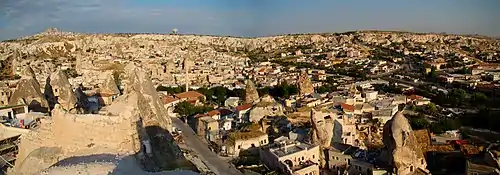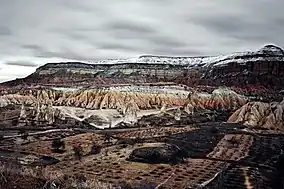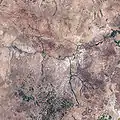Göreme
Göreme (Turkish: [ɟœˈɾeme]; Ancient Greek: Κόραμα, romanized: Kòrama) is a town (belde) in the Nevşehir District, Nevşehir Province in Central Anatolia, Turkey.[2] Its population is 2,034 (2022).[1] It is well known for its fairy chimneys (Turkish: peribacalar), eroded rock formations, many of which were hollowed out in the Middle Ages to create houses, churches and underground cities. Göreme was formerly known as Korama, Matiana, Macan and Avcilar.[3]
Göreme | |
|---|---|
 View of Göreme town | |
 Göreme Location in Turkey  Göreme Göreme (Turkey Central Anatolia) | |
| Coordinates: 38°38′35″N 34°49′44″E | |
| Country | Turkey |
| Province | Nevşehir |
| District | Nevşehir |
| Elevation | 1,104 m (3,622 ft) |
| Population (2022)[1] | 2,034 |
| Time zone | TRT (UTC+3) |
| Website | goreme |
Göreme sits at the heart of a network of valleys filled with astonishing rock formations. It also has the most painted churches in Cappadocia. When the nearby Göreme Valley was designated as the most important tourist centre for Cappadocia (Turkish: Kapadokya), the village's name was changed to Göreme for practical reasons.
Once an agricultural settlement, modern Göreme is best known for its flourishing tourism industry, in particular for its hot air balloon rides[4] and many boutique hotels created out of old cave homes. The village sits within the Göreme National Park which was added to the UNESCO World Heritage List in 1985.[5]
The nearest airports are Nevşehir Kapadokya Airport and Kayseri Airport. The village is also served by long-distance buses from all over Turkey.
History

Very little is known about Göreme's history until modern times in part because it was a small settlement away from the more travelled main roads linking Kayseri to Konya and the Mediterranean coast to Aksaray. The village contains several pillared tombs believed to date back to Roman times. In Byzantine times what is now Göreme was actually two separate but adjacent villages: Corama where the modern Open Air Museum can be found, and Matiana/Macan where the modern village is. The first written record of Matiana and Corama appears in the proceedings of the Council of Chalcedon in 451 which was attended by representatives of both the settlements.[6] A Life oI St Hieron, the patron saint of Göreme,[7] written in the sixth century nevertheless refers to events in the third century and offers the first mention of villagers living in cave houses. Some of the simpler cave churches around the village date from the sixth and seventh centuries, others from the tenth and eleventh centuries which is also when many of the frescoes were painted.
The single finest non-religious building in Göreme was constructed in 1796. It is usually referred to as the Mehmet Paşa Konağı (Mehmet Paşa Mansion) although the true name of the original owner is unknown. The walls of its selamlık (men's room) and haremlik (women's room) are completely covered with murals, those in the men's room featuring images of Constantinople mosques and landscapes, those in the women's room more domestic.[8]
The first Westerner writer to leave an account – and drawing – of Göreme was the French archaeologist Charles Texier who passed through in the 1830s.[9] In a book based on his travels in 1837 Sir William Hamilton referred to the chapel of St Hieron and the so-called Roma Kalesi (Roman Castle) in Göreme.[10]
Troglodytism
The malleable nature of the rocks and cones in and around Göreme has meant that people have carved out cave homes here from at least the third century (and probably from long before). The earliest such homes were probably simple caves but by the 20th century most of the houses (except those in single cones) had stone rooms built in front of the caves for families to live in while the caves were relegated to stabling and storage. The houses were designed to suit a place-specific way of life, with mangers for the animals cut from the rock along with presses used to tread grapes and later to make pekmez (grape molasses). Tandır ovens cut into the floors doubled as heating. This was a way of life that continued right into the first decade of the 21st century but that came to an effective end as a result of a tourism book that saw almost all the old houses converted into boutique hotels by around 2015.[11]
Tourism
Göreme was little visited by tourists until the 1970s but by 2000 had become the tourist capital of Cappadocia. Tourism brought wealth and a better standard of living to the village but it has completely changed not just the use of the old cave buildings within the village which have almost all been converted into hotels but also the lives of the villagers, almost all of whom now work in tourism.[12] Many erstwhile residents have moved to live in the surrounding towns and villages – Nevşehir, Avanos, Uçhisar and Ürgüp – having sold their houses in Göreme for conversion into hotels. In the second decade of the 21st century an increasing number of hotels started to be built or bought by investors from outside Göreme.
Attractions
Modern Göreme is probably best known for its hot-air balloon industry although many visitors also come here to visit the frescoed medieval churches and walk in the network of valleys with their extraordinary rock formations.
The churches
Göreme Open Air Museum (Göreme Açık Hava Müzesi), one of Turkey's most-visited tourist attractions, preserves some of the best of the rock-cut, frescoed churches for which Cappadocia is known.[13] However, there are also a few other churches in and around the village itself: the Bezirhane,[14] Durmus Kadir,[15] Orta Mahaalle, Karabulut,[16] Yusuf Koç churches[17] Aynalı,[18] El Nazar[19] and Saklı[20] churches.
The valleys
Deep valleys run out of Göreme on all sides and make for excellent walking although not all are well signed. Some of them contain little-visited rock-cut churches; most are dotted with pigeon-houses from the days when local farmers reared pigeons to use their guano for fertiliser. Probably the best known of the valleys is Pigeon Valley (Güvercinlik Vadesi) which runs between Göreme and neighbouring Uçhisar. Also popular is the Rose Valley (Güllüdere Vadesi) which contains the remains of the Column Church (Kolonlu Kilise)[21] and several others. Other valleys to explore include the Zemi Valley (Zemi Vadesi), the Valley of the Swords (Kılıçlar Vadesi)[22] and the Kızılçukur Valley.[23]
Gallery

 The Karanlık (Dark) Church
The Karanlık (Dark) Church Göreme cafe owner making flatbread
Göreme cafe owner making flatbread View of Göreme
View of Göreme Göreme national park as seen from space
Göreme national park as seen from space.jpg.webp) The Karanlık (Dark) Church, one of the finest frescoed churches within Göreme Open Air Museum.
The Karanlık (Dark) Church, one of the finest frescoed churches within Göreme Open Air Museum.
See also
References
- "Address-based population registration system (ADNKS) results dated 31 December 2022, Favorite Reports" (XLS). TÜİK. Retrieved 22 May 2023.
- Belde Belediyesi, Turkey Civil Administration Departments Inventory. Retrieved 22 May 2023.
- "Goreme". goreme.org. Retrieved 30 August 2015.
- "CAPPADOCIA HOT AIR BALLOONS: THINGS TO KNOW BEFORE YOU FLY". Journey Era. 19 July 2019. Retrieved 18 August 2022.
- Lynch, Paul; McIntosh, Alison J.; Tucker, Hazel (2 June 2009). Commercial Homes in Tourism: An International Perspective. Routledge. ISBN 978-1-134-03028-6.
- Freely, John (1998). The Western Interior of Turkey (1st ed.). Istanbul: SEV. p. 314. ISBN 9758176226.
- John. "Holy Thirty-Three Martyrs of Melitene, Including Saint Hieron". Retrieved 19 August 2022.
- "GÖREME-KÜÇÜK MEHMET KONAĞI Mayıs 2008 KAPADOKYA". cappadociaexplorer.com. Retrieved 19 August 2022.
- Texier, Charles (1837). Description de l'Asie Mineure (in French) (1st ed.). Paris.
- Hamilton, William (1842). Researches in Asia Minor, Pontus and Armenia (1st ed.). London.
- Emge, Andus. "Old Order in New Space: Change in the Troglodytes Life in Capapdocia". Researchgate.
- Tucker, Hazel (2003). Goreme Lives (1st ed.). London: Routledge. ISBN 9780203987674.
- "Göreme Open-Air Museum | , Turkey | Sights". lonelyplanet.com. Retrieved 18 August 2022.
- "Kültür Envanteri – Göreme Bezirhane Kilisesi". kulturenvanteri.com (in Turkish). 27 March 2020. Retrieved 18 August 2022.
- Borges, Jason (19 November 2019). "Durmuş Kadir Church". Cappadocia History. Retrieved 18 August 2022.
- Borges, Jason (2 December 2019). "Karabulut Church (Zemi Valley)". Cappadocia History. Retrieved 19 August 2022.
- turkeyfromtheinside.com https://www.turkeyfromtheinside.com/places-to-go/y/1472-yusuf-koc-kilise-goereme.html. Retrieved 18 August 2022.
{{cite web}}: Missing or empty|title=(help) - Borges, Jason (9 April 2019). "Aynalı Church". Cappadocia History. Retrieved 21 August 2022.
- Borges, Jason (12 January 2019). "El Nazar Church". Cappadocia History. Retrieved 21 August 2022.
- Borges, Jason (4 October 2019). "Hidden Church (Saklı Kilise)". Cappadocia History. Retrieved 19 August 2022.
- Borges, Jason (10 October 2019). "Column Church". Cappadocia History. Retrieved 21 August 2022.
- dukedillard (21 February 2013). "Capturing the Heart of Cappadocia". captivatingcappadocia.com. Retrieved 21 August 2022.
- Turkey (14th ed.). London: Lonely Planet. 2015. pp. 469–70. ISBN 9781743215777.
External links
- Goreme Open Air Museum: https://www.destinations.com.tr/goreme-open-air-museum/
- "NATIONAL PARKS: Nevsehir – Göreme National Park". Kultur.gov. Turkey: Republic of Turkey. Archived from the original on 4 January 2005.
- "World Heritage Centre/World Heritage List: Göreme National Park and the Rock Sites of Cappadocia". UNESCO.org.
